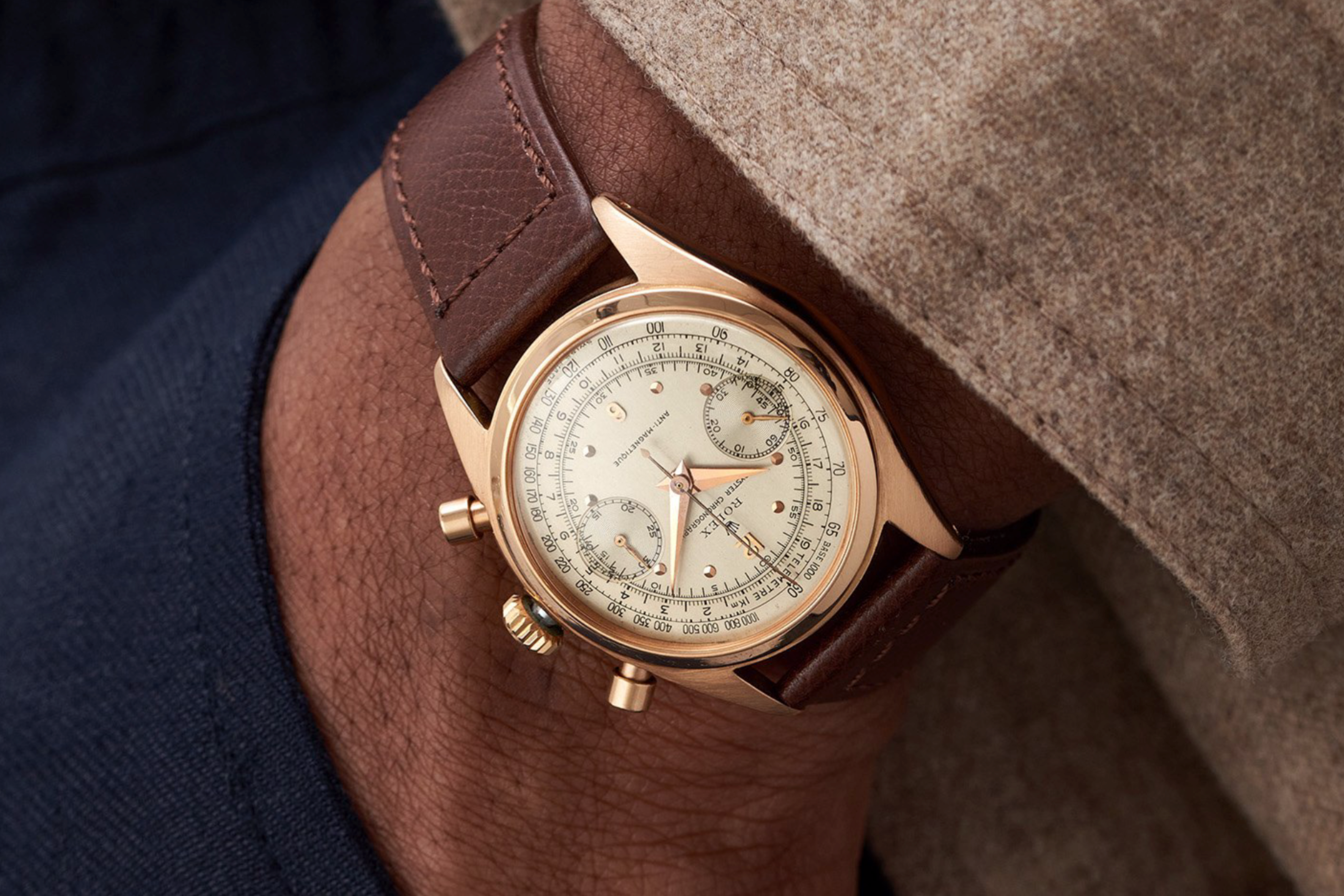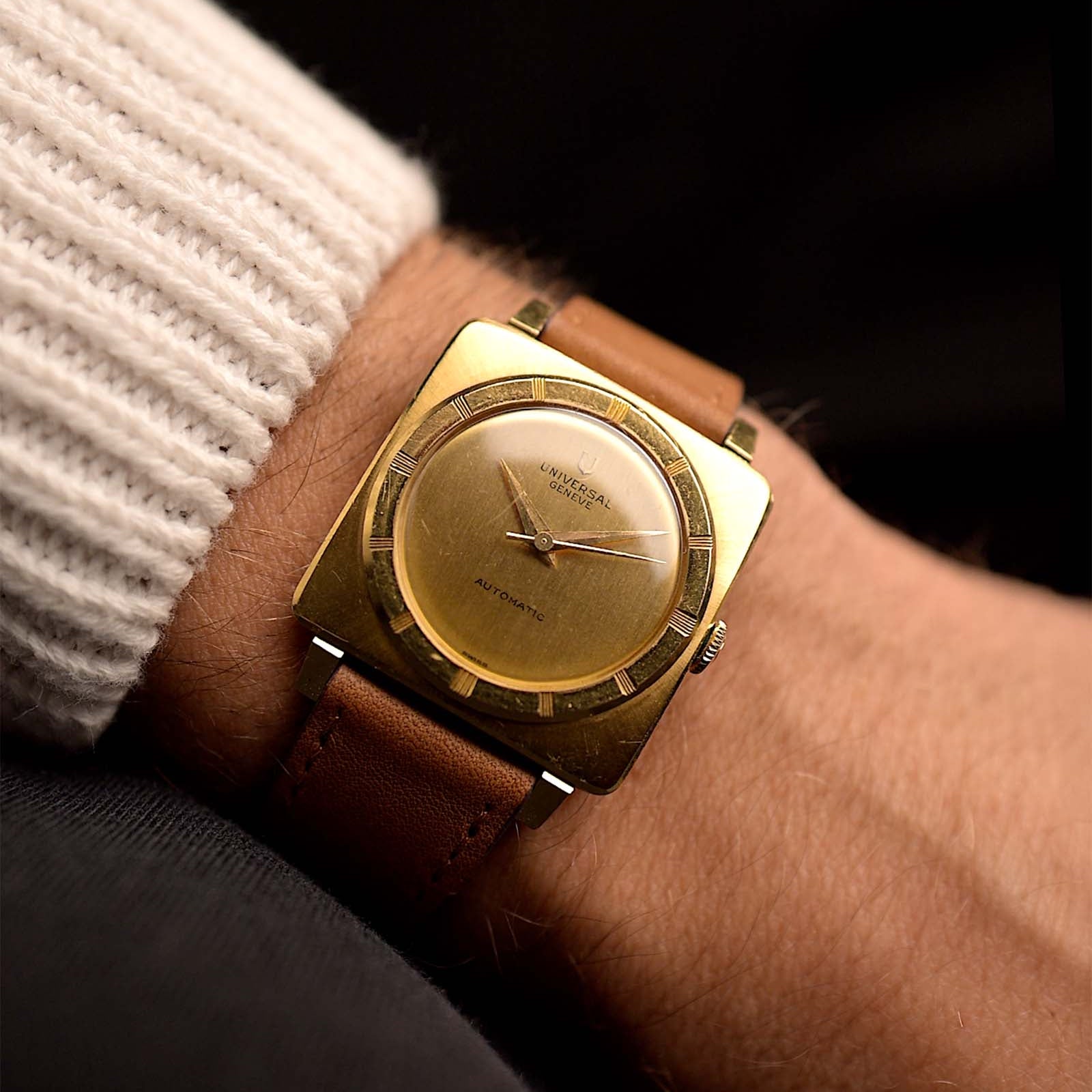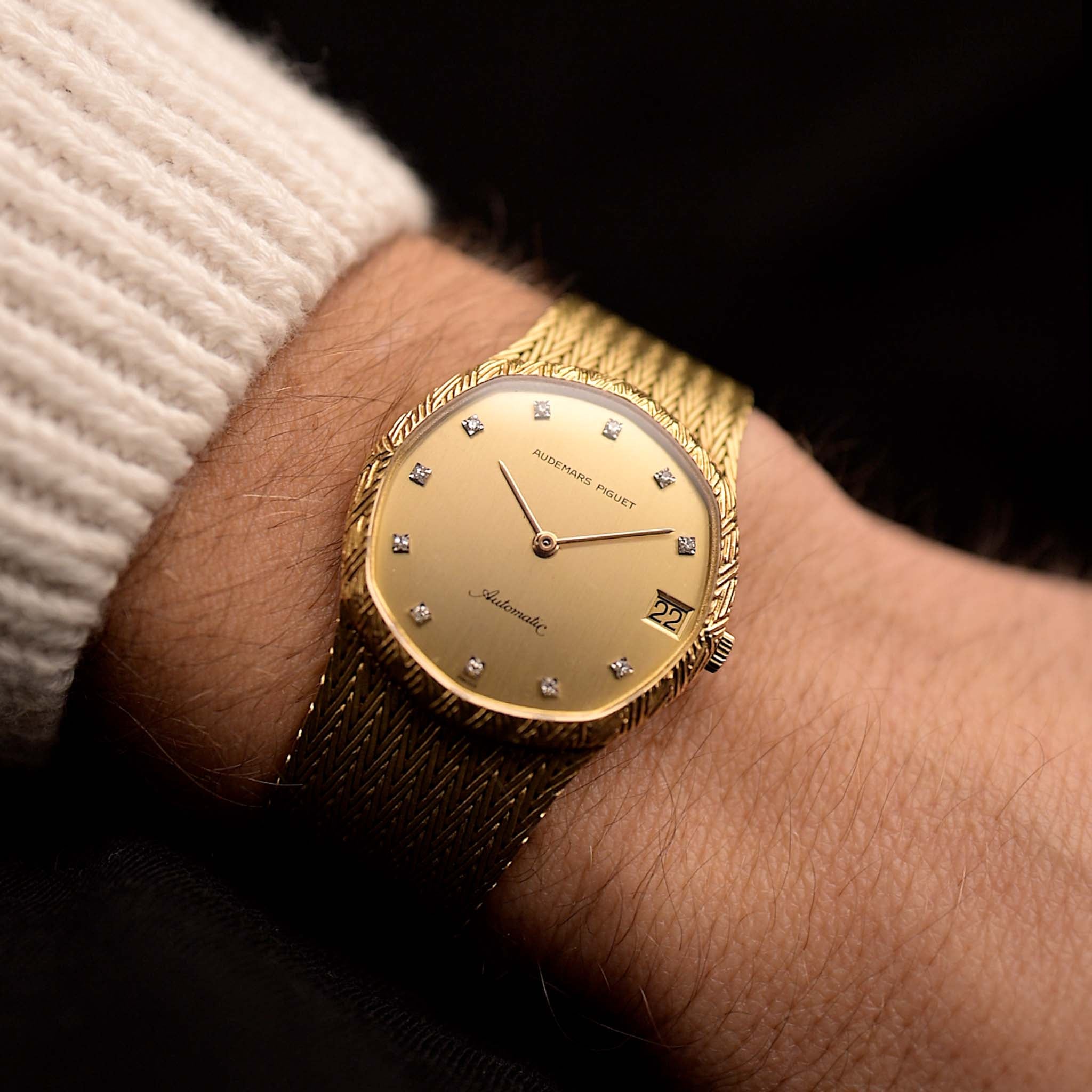We're in this twilight period of Rolex's history. The Pre-Daytona era. It's the time when classic Postwar ideas and designs are put to rest to make place for a new design language. It's the dawn of the Daytona era... but we're not quite there yet. The 6000s references come to life during the 1950s and 60s, in times at which the chronograph itself changes not only its appearance but also its function a well as its image. Rolex did not have its position on top the Ivory Tower just yet. Isn't it fascinating that there was a time when even the Swiss manufacturer had to test the waters on new products and collections weren't set in stone just yet? It's this period that really sparks everything that's about to come...
November 29, 2022
A Beginner's Guide to the Rolex Pre-Daytona (1950-69)

Marcus Siems @siemswatches
Collector, Author, Data Analyst
Earthly not-yet Cosmograph It's about details yet also about big changes. The 1950s and 60s are the epoch in which all chronographs seem to change. From utility over design to the image... everything is in flux. Rolex is no stranger to this turnover - unlike today the Swiss manufacturer did not have its position on top the Ivory Tower just yet. Isn't it fascinating that there was a time when even Rolex had to test the waters on new products and collections weren't set in stone? It's this period with the tension of what's about to come...
So how did we get here? We're in this twilight period of Rolex's history. The time when classic Postwar ideas and designs are put to rest to make place for a new design language. It's the dawn of the Daytona era... but we're not quite there yet.
Rolex introduced a completely new set of chronograph timepieces by 1950, overhauling the existing collection and starting the 6000s references. The Pre-Daytona era of the 1950s and 60s is edged into history as a time in which the chronograph genre itself changes quite drastically. This includes not only the appearance but the function as well as its image[1]. Like mushrooms new, sporty chronograph templates pop up all over Switzerland. The first Heuer Carreras, Breitling Top Times, Omega Speedmasters and so many more were conceived during that period.
 A stunning Rolex 6034 chronograph with tropical black dial - the epiphany of Rolex chic in the 1950s and a hint of what was to come in 1963. Photo Courtesy of Phillips Geneva 2022.
A stunning Rolex 6034 chronograph with tropical black dial - the epiphany of Rolex chic in the 1950s and a hint of what was to come in 1963. Photo Courtesy of Phillips Geneva 2022.
We know where it all ended for Rolex - the Cosmograph Daytona in the mid 1960s. But what happened right before its introduction? How did the Geneva manufacturer transition from old world glory to race track timekeeper?
Here, I try to bridge the gap between the classic chronographs of the 1940s and the sporty specimen of the 1960s... a task Rolex's design department had to go through as well. Rolex's chronograph department wasn't nearly as successful then as it is today and the secret sauce to make a legend hasn't been found just yet.
This is my attempt on a guide of exactly these experimental and transitional 6000s references - and what made them so great. The focus here really is to give a quick and broad overview of this classic watch[2], the design, the history and the production. That said: wherever I may have missed critical information please reach out.
 Before we get all sporty with the Daytona references at some point why not bringing in some smooth golden beauties? One of the most beautiful Rolex chronographs (imho), the reference 6032 in pink gold. Photo Courtesy of Phillips Geneva 2022.
Before we get all sporty with the Daytona references at some point why not bringing in some smooth golden beauties? One of the most beautiful Rolex chronographs (imho), the reference 6032 in pink gold. Photo Courtesy of Phillips Geneva 2022.
1) Pre-Daytona (1950-61)
To get things straight: With the term "Pre-Daytona" I define watches that weren't exactly a Daytona but otherwise had an awful lot in common with the legendary timekeeper. The major difference beside the writing "Daytona" on the dial (which by the way only started to appear in the mid-60s[3]) being that the bezel was still smooth. All Daytonas featured a tachymeter bezel, whereas Pre-Daytonas maximally had a tachymeter often accompanied by a telemeter scale printed to the dial. I further compress the Pre-Daytona era to watches that were produced within the 6000s reference range.
 Comparison of the two-register (left), three-register (middle) and Datocompax (right) Rolex chronographs of the 1950s. The top and bottom row cover the 60xx and 62xx range, respectively.
Comparison of the two-register (left), three-register (middle) and Datocompax (right) Rolex chronographs of the 1950s. The top and bottom row cover the 60xx and 62xx range, respectively.
The basics. First things first: what all the Rolex chronographs from this era have in common is that the feature the famed "Oyster case". This means that both crown and case back can be screwed into the remaining case structure. As mentioned before, all cases feature smooth bezels. Importantly, in contrast to several earlier Rolex chronographs we rarely see dials featuring the "Oyster" but rather many were graced with "Anti-Magnetique" - referring to top-notch movement characteristics of the time.
The dial. Classically these pieces were equipped with manually wound Valjoux caliber 23 (two-register) and caliber 72 (three-register). The dials came in matte black, matte white or silver, and almost all featured both a tachymeter and a telemeter scale at the outer rim. The sub-dials were recessed, sometimes milled yet were not contrasted against the dial color.
 Classy, bold and elegant. The Rolex chronographs of the 1950s (here: 6234). Photo Courtesy of Phillips Geneva 2022.
Classy, bold and elegant. The Rolex chronographs of the 1950s (here: 6234). Photo Courtesy of Phillips Geneva 2022.
The references. The numbering of the references follows a rather simple logic. xx32 are two-register, xx34 three-register, and xx36 Datocompax* chronographs. The 60xx and 62xx references are from a design perspective more or less the same watch. The major difference between the two is that the later 62xx references featured a 3-body case whereas the earlier 60xx came with a 2-body case. The third component on the later series is the bezel. The bezel is also more prominent and broader, almost blending into the case. You can compare the two case designs in the picture below if you zoom into the bezel edge.
 The devil is in the detail. The major difference between the 60xx (left) and 62xx(right) Pre-Daytona series has been the case construction, a detail easily missed at first glance. If you pay close attention to the bezel edge that merges into the case you will see a clear line and shade for the later 62xx (right) in comparison to a smoother transition for the 60xx (left). Further, you will see that the "gap" between bezel and case outline is much smaller for the 62xx (right). Photos Courtesy of Phillips.
The devil is in the detail. The major difference between the 60xx (left) and 62xx(right) Pre-Daytona series has been the case construction, a detail easily missed at first glance. If you pay close attention to the bezel edge that merges into the case you will see a clear line and shade for the later 62xx (right) in comparison to a smoother transition for the 60xx (left). Further, you will see that the "gap" between bezel and case outline is much smaller for the 62xx (right). Photos Courtesy of Phillips.
The french. A slight oddity in the lineup of these Pre-Daytona references is the 6232. Produced in extremely low numbers these pieces might have been produced in particular for the french market[4]. A special experiment for a market that also had tight import taxes for gold products.
2) THE Pre-Daytona - 6238 (1962-69)
The basics. This is the real predecessor - THE Pre-Daytona - the Rolex reference 6238. It's the last overhaul of the sporty Rolex chronograph before the introduction of the Cosmograph/Daytona. Introduced in 1962 it had a solid production run of about 8 years. Interestingly, these pieces were introduced only one year prior to the very first Daytona (6239) and was sold alongside 3(!) Daytona references between 1966-69.
The design. By now the sporty vibe of the collection is strong. The telemeter is completely missing for this reference and the tachymeter is moved further outside. The sub-dials are kept simplistic and in the same color as the dial with milling.
 Sporty yet elegant, not just a true tool-watch yet. The 6238 is simply the right fit for everyone, on the brink between the two worlds of elegant and sporty. The casual chic timekeeper of the 1960s. Photo Courtesy of Phillips.
Sporty yet elegant, not just a true tool-watch yet. The 6238 is simply the right fit for everyone, on the brink between the two worlds of elegant and sporty. The casual chic timekeeper of the 1960s. Photo Courtesy of Phillips.
The Rolex "Carrera". Let's do a little detour here. Overall, Rolex's design is actually quite similar to other classics of the time. Let's have a look at the very first Heuer Carrera ref. 2447 for example. It is a watch that has been introduced in 1963 just a year after the 6238. Both watches actually share several of the main design elements and that includes the faceted hour marker, the milled sub-dials with the exact numeral font and layout and the same movement base with the Valjoux 72[5].
However, this tells us more about the time than the two companies. Both dials were made by Singer, a specialized supplier providing parts to several Swiss companies. Likewise can be said about the movement manufacturer Valjoux. The word in-house movement also wasn't thrown around like today and it was no shame to take in a well-functioning and robust movement from a third-party supplier.
 Take in all the little details... zoomed in to this level the 6238 is not that different from the upcoming Daytona references... or a Heuer Carrera 2447. Erase the signature and it gets tough to tell the two apart. Dial, hour marker, sub-dial layout and font as well as the movement all are shared between the two references. Photo Courtesy of Phillips Geneva May 2019.
Take in all the little details... zoomed in to this level the 6238 is not that different from the upcoming Daytona references... or a Heuer Carrera 2447. Erase the signature and it gets tough to tell the two apart. Dial, hour marker, sub-dial layout and font as well as the movement all are shared between the two references. Photo Courtesy of Phillips Geneva May 2019.
3) Production Numbers
Let's talk rare watches. This adjective is thrown around quite often in the vintage watch world. Frankly most of these items are indeed rare, but some are unicorns and others are just rarely seen. The good thing is we can quantify rarity by the production numbers** (and leave out the "how many survived time" part for now).
 Figure 1. Estimated production of Rolex Pre-Daytona chronograph pieces between 1950-69[6-10].
Figure 1. Estimated production of Rolex Pre-Daytona chronograph pieces between 1950-69[6-10].
For the regular production three-register chronographs production number are in the low thousands. About 3,700 for the ref. 6034, 2,450 ref. 6234 and around 3,600 ref. 6238. over a total production run of 20 years this makes just a little under 500 chronograph pieces produced per year! It's hard to tell how many of these were produced in gold but arguing from the numbers we have on the 6234it might be around 5-10%.
But if you think that is rare take a closer look at the Valjoux 23 powered, two-register chronograph references 6032 and 6232. That bar is not missing. From estimations there probably have been less than three dozens 6032 and 6232 combined. Around 10-20 6032s and about a dozen 6232s, really underscoring the experimental character of these pieces and Rolex's approach at the time.
4) The Conclusion
Putting all the pieces back together we can see that Rolex's strategy at the time appears a bit like trial-and-error. There's a massive turnaround for the entire chronograph genre between 1950 and the mid 1960s and Rolex had to test the waters as well.
If we look closer into the "strategy" we still observe a strong preference - three-register chronographs based on the Valjoux 72 movement in stark contrast to what we've seen before 1950. Almost the entire production volume during the 20 year period (1950-69) has been based on this dial and movement configuration.
 The profile of a new generation of modern chronographs. The 6238 is truly on point when it comes to the racing spirit of the 1960s chronographs and already a hint to what's to come next from Rolex. Photo Courtesy of Phillips.
The profile of a new generation of modern chronographs. The 6238 is truly on point when it comes to the racing spirit of the 1960s chronographs and already a hint to what's to come next from Rolex. Photo Courtesy of Phillips.
The third register indicates the elapsed hours. Well, Rolex was highly invested in motor racing at the time, after all they started to sponsor the 24h of Daytona in the mid 1960s. Keeping record of longer periods of time was definitely en Vogue and just the right feature you need to underline the focus of your brands chronographs.
Between 1950 and 1963 - the year of the introduction of the Cosmograph "Daytona" - it truly is a transitional period for the brand and many features of the most coveted chronograph watch of our time arise and are sprinkled all over different references but the secret ingredients are still missing.
And I'll tell you in the next part of the series what exactly make the recipe for the Daytona so special.
Wanna know more about Rolex chronographs? Find all parts of the series here:
- Early Rolex Chronographs (1935-52)
- Rolex Pre-Daytona Chronographs (1950-69)
- Rolex Daytona 4-Digit (1963-88)
* Even though I bring up the Datocompax for completeness here, I do not explicitly cover the "Jean-Claude Killy" references in this guide. This is beyond the scope of this overview.
** Never forget: production numbers for vintage Rolex are not hard facts. These are estimates based on expert knowledge.
References
[1] What Makes a Chronograph Look Like a Chronograph?; Marcus Siems, Goldammer Vintage Watches;
https://goldammer.me/blogs/articles/chronograph-essence
[2] Family Tree: Rolex Pre-Daytona; Lorenzo Rabbiosi, The Watch Boutique;
https://www.thewatchboutique.com/en/2022/04/15/family-tree-rolex-pre-daytona/
[3] Everything You Need To Know About The Rolex Daytona; Danny Milton, Hodinkee;
https://www.hodinkee.com/articles/understanding-the-rolex-non-paul-newman-daytona
[4] Rolex ref. 6232; Phillips Geneva June 2020
[5] In-Depth: The Very First Heuer Carrera, Explained; Eric Wind, Hodinkee;
https://www.hodinkee.com/articles/understanding-the-earliest-heuer-carreras
[6] Rolex ref. 6032; Le Monde Edmond
[7] Rolex ref. 6034; The Watch Boutique
[8] Rolex ref. 6232; Phillips Geneva June 2020
[9] Rolex ref. 6234; Phillips Geneva Nov. 2022
[10] Rolex ref. 6238; Dr. Crott Nov. 2022, The Watch Boutique & Bob's Watches
And a special thank you to the almost limitless archives at Le Monde Edmond, the publications by John Goldberger and the Collector's Square.
All rights on text and graphics reserved to the Author.




























2 comments
Bonjour, j’ai une rolex, don le numéro de série et le 2921 031832, elle et très ancienne, je voudrais en savoir plus, et la faire expertiser si possible merci
Dear goldammer.me webmaster, Thanks for the well-organized and comprehensive post!
Leave a comment